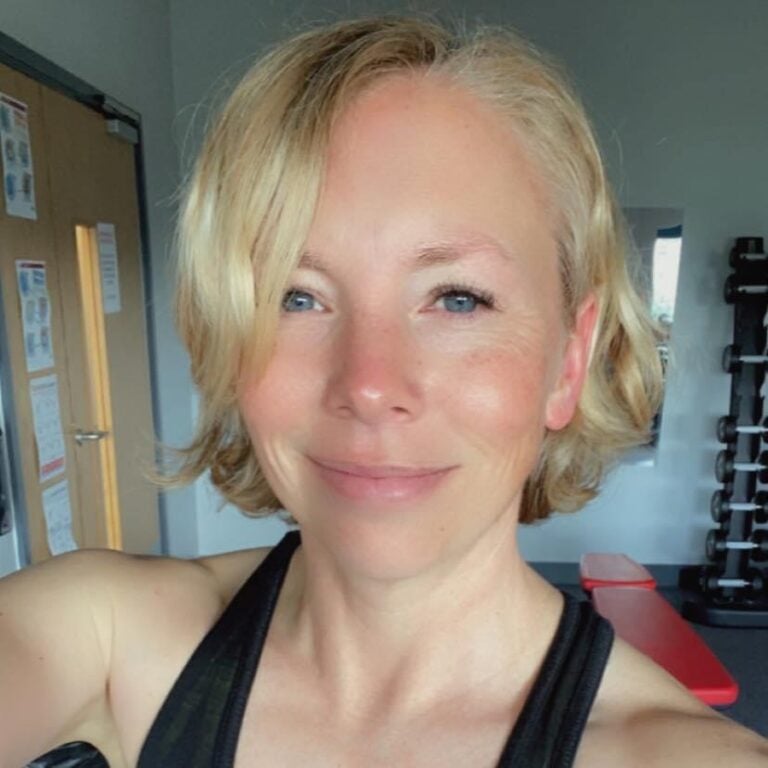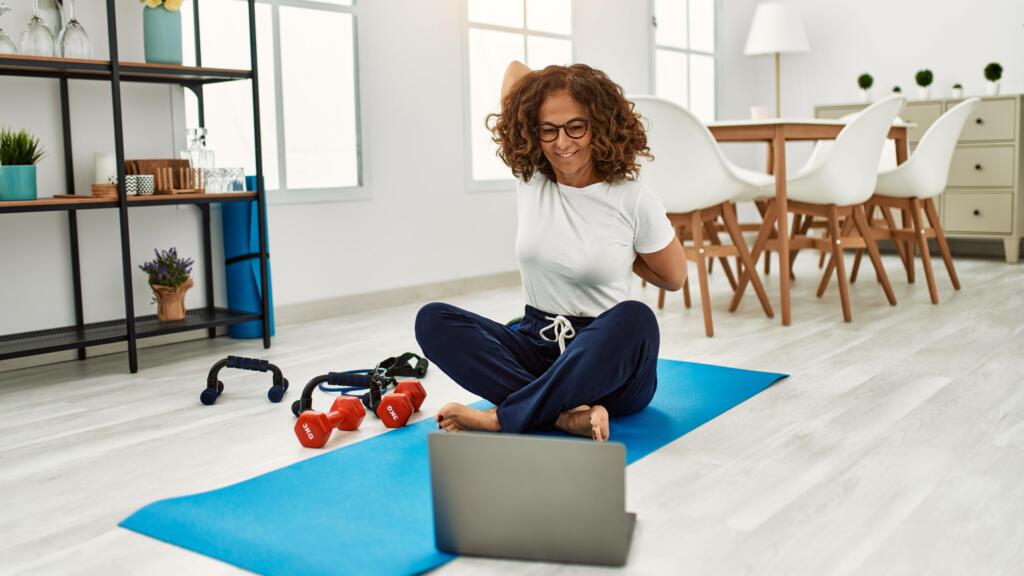
How to start exercising in later life: tips from the UK’s oldest personal trainer
Becky Fuller
If you want to start exercising at home, try these simple exercises that will help you get fitter.
Getting fit doesn’t need to be complicated, nor does it need to cost the earth. All you need is a bit of space at home, some water and a towel and you’re good to go. The benefits of strength training as we age are numerous, helping to protect our joints and bones, as well as increasing mobility and flexibility. If you’ve not done it before, the nine exercises listed below are all suitable for trying out at home and need no equipment.
If you find you like them, the next step would be to add some dumbbells to the routine – I’ll show you how throughout. From there, if you’re bitten by the strength training bug, you might like to think about a gym membership. Many gyms offer discounted over-50s or off-peak prices, and you’ll have access to a wide range of equipment and classes.
Getting fit doesn’t need to be complicated, nor does it need to cost the earth. All you need is a bit of space at home, some water and a towel and you’re good to go. The benefits of strength training as we age are numerous, helping to protect our joints and bones, as well as increasing mobility and flexibility. If you’ve not done it before, the nine exercises listed below are all suitable for trying out at home and need no equipment.
If you find you like them, the next step would be to add some dumbbells to the routine – I’ll show you how throughout. From there, if you’re bitten by the strength training bug, you might like to think about a gym membership. Many gyms offer discounted over-50s or off-peak prices, and you’ll have access to a wide range of equipment and classes.
 Credit: Shutterstock / antoniodiaz
Credit: Shutterstock / antoniodiazHome workouts are great for many reasons. First, you can do them whenever you please. Second, no one else is watching you (unless you choose to exercise with a partner or friend, of course). You can make as many mistakes as you want, try as many times as you like, and no one is any the wiser. You can also wear what you want – I’ve been known to exercise in my pyjamas!
The exercises I’ve listed can be tried individually or put together for a full-body workout that will last around 15 minutes. You can also mix and match as you choose, so if you don’t like a certain exercise or it’s not suitable, just take it out or repeat another exercise in its place. For the best results, pair these strength training exercises with some cardio exercise throughout the week.
If you have any pre-existing injuries or medical issues, please consult your doctor before starting a new exercise regime. Be sure to warm up before you begin – walk around the house to get the blood flowing to your muscles, or follow our warm–up exercises.
If possible, do these exercises on a hard floor. If that’s not an option, I would strongly suggest going barefoot so you can grip the floor better. Keep a chair on hand if balance is an issue, or hold on to the mantelpiece, like I do.
 Credit: Saga Exceptional
Credit: Saga Exceptional How to do it:
Make this easier: Squat down to sit on the edge of a (hard) chair or hold on to the back of a chair with one hand as you squat.
Make this harder: Point your hands towards the floor, between your knees, and try to touch your fingers to the floor, or hold a weight while you squat.
 Credit: Saga Exceptional
Credit: Saga Exceptional How to do it:
Top tip: Don’t take too large a step back, as it becomes hard to balance.
Make this easier: Hold on to the back of a chair with one hand, or don’t lunge too deep (your knee doesn’t need to touch the floor).
Make this harder: As you stand, lift the knee up above the waist, then lunge back down again. Alternatively, hold a pair of dumbbells at your side.
 Credit: Saga Exceptional
Credit: Saga Exceptional How to do it:
Top tip: Always keep your feet flat on the floor. If your heels come up, reduce the size of your sidestep.
Make this easier: Reduce the size of your sidestep and don’t bend the knee as much.
Make this harder: Hold either one dumbbell centrally at chest height, or hold two and bring them across to frame the bent knee on every rep.
 Credit: Saga Exceptional
Credit: Saga Exceptional How to do it:
Make this easier: It’s a good idea to hold on to something with one hand, especially when you’re getting used to it.
Make this harder: Aim to get the leg completely straight in line with your hip each time. You can also hold one dumbbell in the hand on the side of the working leg (the one that’s moving).
You might want to put a mat or towel on the floor for these exercises to protect your hands or knees. These are quite challenging, so feel free to make them easier to start with, and work towards mastering them.
 Credit: Saga Exceptional
Credit: Saga Exceptional How to do it:
Make this easier: Follow our guide on how to do a push up, which includes details on how to do wall push ups, incline push ups and knee down push ups.
Make this harder: Add a three-second hold at the bottom of each push up or add more repetitions.
 Credit: Saga Exceptional
Credit: Saga Exceptional How to do it:
Make this easier: You can place your hands on the edge of a chair instead and do your dips from there. Reduce the range of motion to make it easier.
Make this harder: Again, using the chair, concentrate on dipping as low as you can. For an extra challenge, place your feet on another chair.
When trainers talk about “core”, we aren’t just referring to stomach muscles. The core muscles include all the muscles in the stomach, lower back and glutes (bum). Think of it like a ring around the lower part of your torso. It’s just as important to work the muscles in your back as your stomach.
You might want to lie on a mat or towel for these exercises.
 Credit: Saga Exceptional
Credit: Saga Exceptional How to do it:
Make this easier: Just lift the top half of your body, leaving the legs in place. You might also find it easier to start with your arms extended out in front of you.
Make this harder: At the top of the movement, hold it and extend the arms out in front, then back to the starting position before lowering back down.
 Credit: Saga Exceptional
Credit: Saga Exceptional How to do it:
Make this easier: Pop a cushion or rolled-up towel under your head if lifting it for a prolonged period is an issue. Reach towards the calves if mobility is a problem.
Make this harder: Do all reps on one side, then the other.
 Credit: Saga Exceptional
Credit: Saga Exceptional How to do it:
Make this easier: Hold the same plank position, but with your knees on the floor. Alternatively, try a wall sit for a good core exercise that doesn’t involve going to the floor.
Make this harder: Hold the plank for longer – or for a real challenge, hold the plank on your hands (high plank), and tap your hands to the opposite shoulder for 10 repetitions each round.

Written by Becky Fuller she/her
Published:
Becky Fuller is a fully qualified Personal Trainer, specialising in strength and conditioning for over 50s. Becky’s focus is helping people to become stronger both in body and mind, and to move well without pain. Becky also has many years’ experience working as a freelance journalist, writing for a wide variety of publications such as Screen Rant, Geek Feed, and Daily Actor. She also regularly reviews theatre productions for UKTW.

Becky Fuller

Becky Fuller

Becky Fuller

Becky Fuller